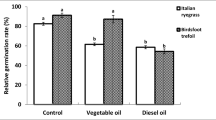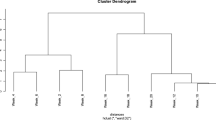Abstract
Hydrocarbons are the main components of diesel oil and are toxic for the majority of plants. A few plant species, known as phytoremediators, are tolerant of hydrocarbons and can survive the stressful conditions of soils contaminated with diesel oil. Canavalia ensiformis, a plant species that is well distributed throughout the tropics, possesses advantageous features for a potential resistance to soil contamination, such as fast growth and a deep root system. Thus, the aim of the present study was to evaluate the tolerance of C. ensiformis when it was exposed to soil contaminated with diesel oil. Seedlings were subjected to two treatments: contaminated soil (CS) (95 ml/kg of diesel oil) and non-contaminated soil (NCS) for a period of 30 days; its growth, morphology, anatomy, and physiology were analyzed. Despite the high level of toxicity, some individuals were able to survive in CS. These plants had root apical meristems with high levels of mitosis and were able to issue new roots with more developed aerenchyma tissue. Because the surviving plants presented no marks of cellular damage on the organs formed (root and leaves) during the experiment, the species capacity of growth on CS was confirmed. Although, long-term field experiments, applying different contaminant concentrations, should be considered to infer about the species resistance and use as phytoremediator.








Similar content being viewed by others
References
Achuba FI (2006) The effect of sublethal concentrations of crude oil on the growth and metabolism of cowpea (Vigna unguiculata) seedlings. Environmentalist 26:17–20
Adam G, Duncan HJ (1999) Effect of diesel fuel on growth of selected plant species. Environ Geochem Health 21:353–357
Adenipekun CO, Oyetunji OJ, Kassim LQ (2008) Effect of spent engine oil on the growth parameters and chlorophyll content of Corchorus olitorius Linn. Environmentalist 28:446–450
Alkio M, Tabuchi TM, Wang X, Colón-Carmona A (2005) Stress responses to polycyclic aromatic hydrocarbons in Arabidopsis include growth inhibition and hypersensitive response-like symptoms. J Exp Bot 56(421):2983–2994
Alvarenga RC, Da Costa LM, Moura Filho W, Regazzi AJ (1995) Characteristics of some green manures of interest for conservation and soil restoration. Pesq Agrop Brasileira 30(2):175–185 in Portuguese
Armstrong W (1979) Aeration in higher plants. Adv Bot Res 7:226–332
Blokhina O, Virolainen E, Fagerstedt KV (2003) Antioxidants, oxidative damage and oxygen deprivation stress: a review. Ann Bot 91(2):179–194
Bona C, Da Silva MYB, Rezende IG, Santos GO, Souza LA, Inckot RC (2011) Effect of diesel contaminated soil in the structure of the root and leaf of Sebastiania commersoniana seedlings (Euphorbiaceae) and Schinus terebinthifolius (Anacardiaceae). Acta Botanica Brasilica 25(2):277–285 in Portuguese
Chupakhina GN, Maslennikov PV (2004) Plant adaptation to oil stress. Russ J Ecol 35(5):290–295
Cunningham SD, Berti WR, Huang JW (1995) Phytoremediation of contaminated soils. Tibtech 13:393–397
De Farias V, Maranho LT, De Vasconcelos EC, da Silva Carvalho Filho MA, Lacerda LG, Azevedo JAM, Pandey A, Soccol CR (2009) Phytodegradation potential of Erythrina crista-galli L., Fabaceae, in petroleum contaminated soil. Applied Biochemistry Biotechnology 157:10–22
Entry JA, Rygiewicz PT, Watrud LS, Donnelly PK (2002) Influence of adverse soil conditions on the formation and function of Arbuscular mycorrhizas. Adv Environ Res 7:123–138
FISPQ (2016) Chemical Product Safety Data Sheet – Diesel Oil S500. http://www.br.com.br/wps/wcm/connect/f69c2f0043a796c4b3f4bfecc2d0136c/fispq-oleodiesel-s500.pdf?MOD=AJPERES. Accessed 01 August 2016 (in Portuguese)
Gogosz AM, Bona C, Santos GO, Botosso PC (2010) Germination and initial growth of Campomanesia xanthocarpa O. Berg. (Myrtaceae), in petroleum contaminated soil and bioremediated soil. Braz J Biol 70(4):977–986
Gudin C, Syratt WJ (1975) Biological aspects of land rehabilitation following hydrocarbon contamination. Environ Pollut 8:107–112
Hawrot-Paw M, Bakowska T (2014) Growth and development of selected plant species in the phytoremediation of diesel oil contaminated soil. Environ Prot Eng 40(4):5–13
Huang XD, El-Alawi Y, Penrose DM, Glick BR, Greenberg BM (2004) A multi-process phytoremediation system for removal of polycyclic aromatic hydrocarbons from contaminated soils. Environ Pollut 130:465–476
Inckot RC, Bona C, De Souza LA, Santos GO (2008) Anatomy of Mimosa pilulifera (Fabaceae) seedlings growing in an oil contaminated and bioremediated soil. Rodriguesia 59(3):513–524 in Portuguese
Johansen DA (1940) Plant microtechnique. McGraw-Hill Book Company, New York
Karnovsky MJ (1965) A formaldehyde-glutaraldehyde fixative of high osmolatily for use in electron microscopy. J Cell Biol 27:137A–138A
Kim KD (2014) Effects of diesel and kerosene on germination and growth of coastal wetland plant species. Bulletin Environmental Contamination Toxicology 93:596–602
Kraus JE, Arduin M (1997) Basic methods manual about plant morphology. EDUR, Rio de Janeiro in Portuguese
Lichtenthaler HK, Wellburn AR (1983) Determinations of total carotenoids and chlorophylls a and b of leaf extracts in different solvents. Biochem Soc Trans 11(5):591–592
Lopes OMN (2000) Canavalia ensiformis. Legumes to control weeds and green soil fertilization. Altamira: Embrapa Comunicado Técnico n°12. (in Portuguese)
Malallah G, Afzal M, Gulsham S, Abraham D, Kurian M, Dhami MSI (1996) Vicia faba as a bioindicator of oil pollution. Environ Pollut 92(2):213–217
Malallah G, Afial M, Kurian M, Gulshan S, Dhami MSI (1998) Impact of oil pollution plants on some desert. Environ Int 24(8):919–924
Merkl N, Schultze-Kraft R, Infante C (2004) Phytoremediation in tropics—the effect of crude oil on the growth on tropical plants. Biorremediation Journal 8(3–4):177–184
Minai-Tehrani D, Mohammadi MK (2014) Crude oil-polluted soil induces ultrastructural and enzyme activity changes in the shoot of lentil. Journal of Stress Physiology & Biochemistry 10(1):112–121
Nakata C, Qualizza C, MacKinnon M, Renault S (2011) Growth and physiological responses of Triticum aestivum and Deschampsia caespitosa exposed to petroleum coke. Water Air Soil Pollution 216:59–72
Odjegba VJ, Sadiq AO (2002) Effects of spent engine oil on the growth parameters, chlorophyll and protein levels of Amaranthus hybridus L. Environmentalist 22:23–28
Osuagwu AN, Okigbo AU, Ekpo IA, Chukwurah PN, Agbor RB (2013) Effect of crude oil pollution on growth parameters, chlorophyll content and bulbils yield in air potato (Dioscorea bulbifera L.). International Journal of Applied 3(4):37–42
Pearse AGE (1961) Histochemistry: theoretical and applied. 2ed. London
Roswell MJ (1977) The effect of crude of spills on soils. In: Good JA The reclamation of agricultural soils after oil spills. Dept. of Soil Science, University of Alberta, Edmond, pp 1–33
Sadunishvili T, Kvesitadze E, Betsiashvili M, Kuprava N, Zaalishvili G, Kvesitadze G (2009) Influence of hydrocarbons on plant cell ultrastructure and main metabolic enzymes. World Acad Sci Eng Technol 3:261–266
Sass JE (1951) Botanical microtechnique. 2ed. Iowa State College Press, Iwoa
Smit B, Stachowiak M, Volkenburgh EV (1989) Cellular processes limiting leaf growth in plants under hypoxic root stress. J Exp Bot 40(210):89–94
Suominen L, Jussila MM, Mäkeläinen K, Romantschuk M, Lindström K (2000) Evaluation of the Galega-Rhizobium galegae system for the bioremediation of oil-contaminated soil. Environ Pollut 107:239–244
Vollenweider P, Ottiger M, Günthardt-Goerg MS (2003) Validation of leaf ozone symptoms in natural vegetation using microscopical methods. Environ Pollut 124:101–118
Werner D, Neumann H, Scheidemann P, Bode-Kirchhoff A, Wetzel A (1999) Bioassays for soil contamination using the legume root nodule symbiosis. In: Martínez E, Hernández G Highlights of nitrogen fixation research, Kluwer Academic/Plenum Publishers, London 231–235
Zand AD, Bidhendi GN, Mehrdadi N (2010) Phytoremediation of total petroleum hydrocarbons (TPHs) using plant species in Iran. Turk J Agric For 34:429–438
Acknowledgments
We would like to thank the Araucaria Foundation for project financing (n°10156), the Department of Botany and Electron Microscopy Center (Universidade Federal do Paraná) for the laboratories and equipment and CNPq for the support.
Author information
Authors and Affiliations
Corresponding author
Additional information
Responsible editor: Philippe Garrigues
Rights and permissions
About this article
Cite this article
Balliana, A.G., Moura, B.B., Inckot, R.C. et al. Development of Canavalia ensiformis in soil contaminated with diesel oil. Environ Sci Pollut Res 24, 979–986 (2017). https://doi.org/10.1007/s11356-016-7674-1
Received:
Accepted:
Published:
Issue Date:
DOI: https://doi.org/10.1007/s11356-016-7674-1




